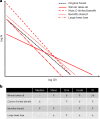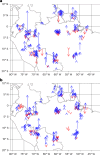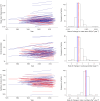Increasing tree size across Amazonia
- PMID: 40999006
- PMCID: PMC12537487
- DOI: 10.1038/s41477-025-02097-4
Increasing tree size across Amazonia
Abstract
Climate change and increasing availability of resources such as carbon dioxide are modifying forest functioning worldwide, but the effects of these changes on forest structure are unclear. As additional resources become available, for example, through CO2 fertilization or nitrogen deposition, large trees, with greater access to light, may be expected to gain further advantages. Conversely, smaller light-suppressed trees might benefit more if their light compensation point changes, while bigger trees may be the most negatively impacted by increasing heat and drought. We assessed recent changes in the structure of Earth's largest tropical forest by analysing 30 years of Amazonian tree records across 188 mature forest plots. We find that, at a stand level, trees have become larger over time, with mean tree basal area increasing by 3.3% per decade (95% CI 2.4; 4.1). Larger trees have increased in both number and size, yet we observed similar rates of relative size gain in large and small trees. This evidence is consistent with a resource-driven boost for larger trees but also a reduction in suppression among smaller trees. These results, especially the persistence and consistency of tree size increases across Amazonian forest plots, communities and regions, indicate that any negative impacts of climate change on forests and large trees here have so far been mitigated by the positive effects of increased resources.
© 2025. The Author(s).
Conflict of interest statement
Competing interests: The authors declare no competing interests.
Figures











References
-
- Pan, Y. et al. The enduring world forest carbon sink. Nature631, 563–569 (2024). - PubMed
-
- Brienen, R. J. W. et al. Long-term decline of the Amazon carbon sink. Nature519, 344–348 (2015). - PubMed
-
- Phillips, O. L. et al. Changes in the carbon balance of tropical forests: evidence from long-term plots. Science282, 439–442 (1998). - PubMed
-
- Bauman, D. et al. Tropical tree mortality has increased with rising atmospheric water stress. Nature608, 528–533 (2022). - PubMed
MeSH terms
Grants and funding
LinkOut - more resources
Full Text Sources
Medical
Research Materials

